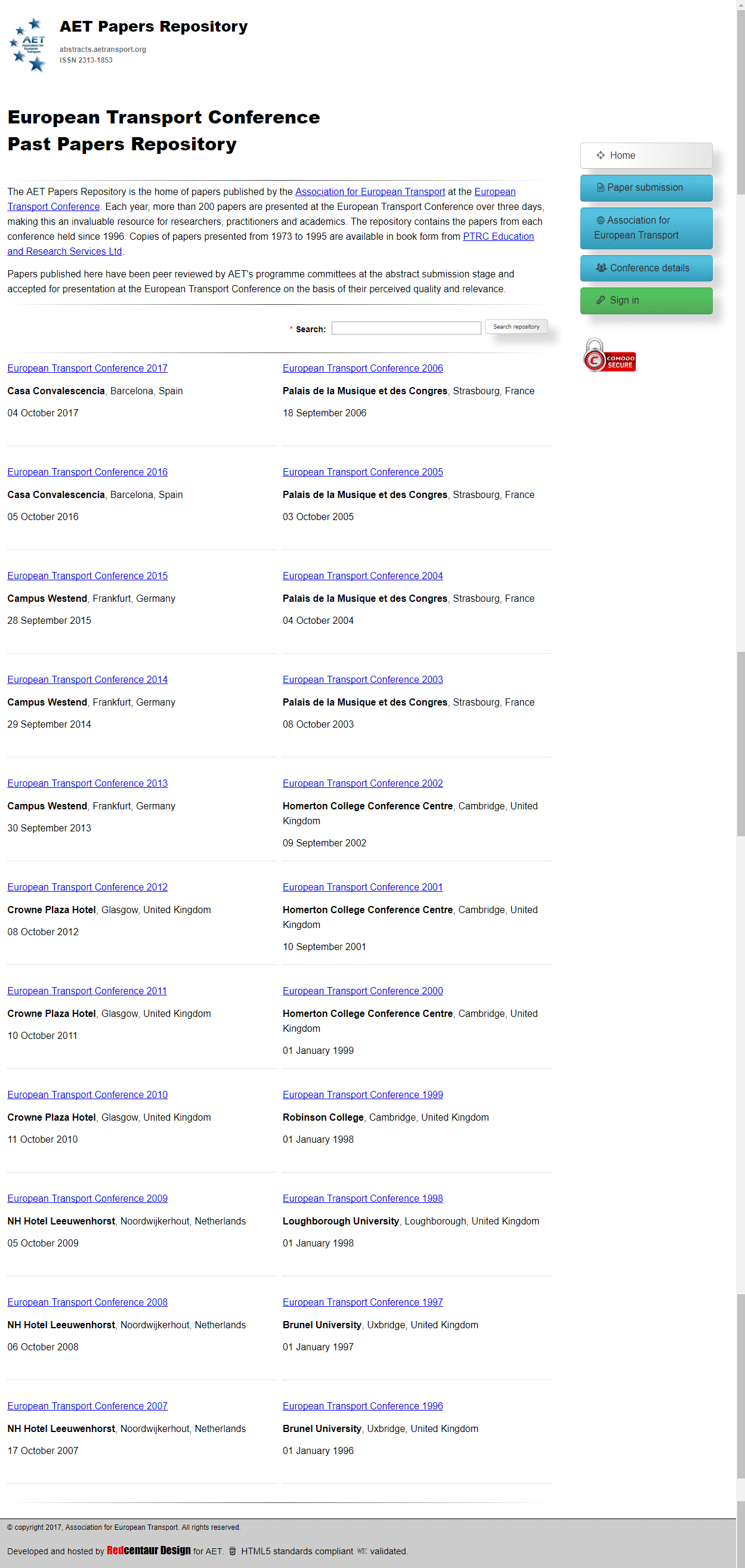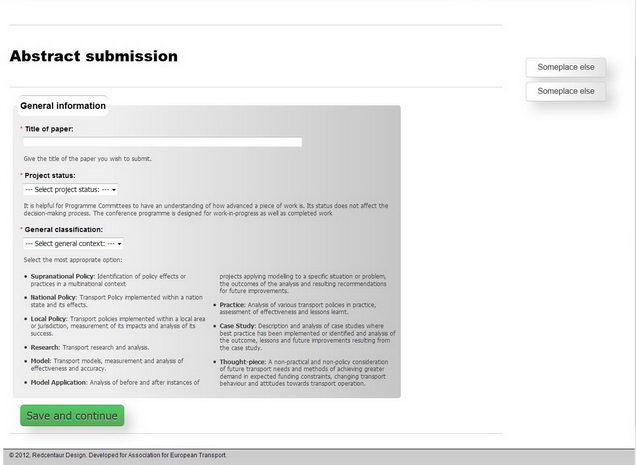Abstracts and papers web site
This project for the Association for European Transport (AET) developed a web site to submit, store, process, and publish abstracts and papers for the annual European Transport Conference.
Project details
| Client: | Association for European Transport |
| Project: | Abstracts and papers web site |
| Date: | 12 Apr 2011 |
Scope
The scope of the project was:
- to redesign the data structure of the papers web site;
- convert the database to a modern, usable standard;
- redevelop the web site to make it easier for users and administrators to participate in the papers submission process; and,
- ensure that papers were published on the site after the conference finished.
The previous conference web site was in two parts. First, the submission site was a separate entity under a different domain name. Second, the conference papers web site stored historical information and past papers for previous conferences.
Our solution
We designed a new database structure for the tremendous amount of data available for papers submitted to previous conferences. Then we carefully transferred the data across to the new database structure while ensuring the data’s integrity. As we undertook this lengthy process, we started developing the new web site for submissions to future conferences.
In our view, there were a few crucial requirements in need of fulfilment; namely, the web site had to:
- improve functionality for users to submit abstracts;
- provide new functionality for reviewers to review submissions, select papers, and create a conference programme; and,
- enable administrators to create and organise conference programmes, and add documents to sessions.
Our solution was to combine the two separated parts of the conference process into a single web site for the first time. We believed a valuable improvement would be the potential to submit and retrieve papers on the same web site.
Successes
The new database structure enabled the data to be accessed more efficiently and quickly, improving the web site’s response times. Additionally, the new functionality was a critical improvement, speeding up some of the organisation’s processes.
Users experienced easier access to past research and papers through the web site because of its simple front–end design, which put the abstracts, papers and conference programme at the heart of the web site. Users could submit abstracts and find conference papers on one web site, rather than using different processes across two domains. Likewise, administrators no longer had to transfer data from one web site to another when conference papers were published: the site already held all the data and automatically published the necessary information.
Conference programming was also improved by the web site, making it quicker and easier for administrators to set up and programme conference sessions. The web site had the power to automate many mundane tasks, allowing administrators to work quicker.
Challenges
One of the biggest challenges was the transfer of existing data to the new database.
There were three significant obstacles in this challenge. The first was the level of inconsistency and anomalous data within the existing dataset. All of which we were obliged to correct before transfer to the new database.
The second obstacle was the structure of the current dataset. For some time, various people incorporated new data elements into that dataset. Often, this meant extending the scope of a table already in use; or adding a new table and duplicating significant amounts of data across two or more tables. We unpicked the trails of data across the database and simplified the dataset significantly during the transfer process. Meeting this challenge improved the performance of database queries and web site speed.
The third obstacle was the insecurity of the current dataset. Specifically, personal data, critical information and passwords were in plain text throughout the database without encryption. We removed any unnecessary personal information, making the dataset more manageable with every removal. We also ensured that the storage of personal data was secure, encrypted and safe. To do this, we forced users to create a new password and encrypted data stored in the database with an industrial-strength cryptographic algorithm.
The dataset was massive, inconsistent, poorly organised, inefficient and insecure. We necessarily changed and updated the data structure to remedy these problems and bring the data into line with data management standards. It was an immense undertaking to test and iterate before we were confident that the completed transfer was accurate.
Impacts of the project
Since the project completion, the web site witnessed a 25% increase in traffic, including both search engine and direct traffic. Bounce rates (the number of visitors leaving the web site on the first page) and drop–offs (the number of visitors leaving the web site while a page was loading) have reduced significantly since the new web site launched.
There has been a significant saving in administrative time required to organise and manage conference paper submissions and programming because of the automated processing features we incorporated into the application.
Statistics also show that database query time has significantly reduced. Reducing database response times improves site performance and speed, which is excellent for visitors and search engine rankings.
PDF download
You can download a copy of this case study for your reference here (downloads a PDF file of this case study to your computer) .


